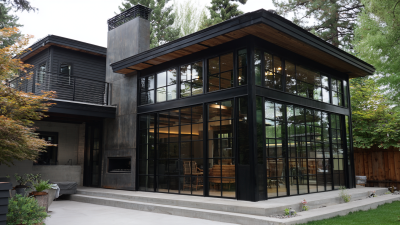In today's competitive housing market, the significance of selecting the right residential windows and doors cannot be overstated. According to a recent report by the American Institute of Architects, high-quality windows and doors can enhance a home's energy efficiency by up to 30%, leading to substantial savings on energy bills and a reduced carbon footprint. Furthermore, the U.S. Department of Energy emphasizes that properly installed residential windows can contribute to improved indoor comfort and reduced HVAC costs. As global buyers seek sustainable and efficient home solutions, understanding the various materials, styles, and technologies available in residential windows and doors is crucial. This comprehensive guide aims to equip buyers with the knowledge necessary to make informed decisions that not only elevate home aesthetics but also provide long-lasting value and performance.

When selecting residential windows and doors, buyers must consider essential features that will impact both aesthetics and functionality. Energy efficiency is a top priority; according to the U.S. Department of Energy, windows account for 25%-30% of residential heating and cooling energy use. Thus, opting for ENERGY STAR certified products can reduce energy bills significantly, often by as much as 12% compared to non-certified alternatives. Look for windows with double or triple glazing and low-E coatings, which can enhance insulation and minimize heat loss.
Durability and security are also critical factors. Reports from the American Architectural Manufacturers Association indicate that well-constructed windows and doors can withstand extreme weather conditions, reducing the risk of costly repairs. Additionally, features like multi-point locking systems and laminated glass are essential for enhancing security, making homes less vulnerable to break-ins. Buyers should prioritize materials such as fiberglass or vinyl that offer low maintenance while standing up to environmental stressors, ensuring longevity and peace of mind in their investment.
When selecting residential windows and doors, understanding energy efficiency ratings, particularly the U-Factor and Solar Heat Gain Coefficient (SHGC), is essential for making informed choices. The U-Factor measures the rate of heat transfer and indicates how well a window insulates. A lower U-Factor signifies better insulation, which can significantly reduce heating and cooling costs, resulting in a more comfortable living environment. Conversely, the SHGC measures how much solar radiation passes through a window. High SHGC values are beneficial in colder climates, where natural warmth from sunlight can reduce reliance on heating systems. However, in warmer regions, optimizing for lower SHGC values helps minimize cooling demands.
Research indicates that one-third of the world's energy is consumed by buildings, contributing significantly to global CO2 emissions. Implementing energy-efficient windows can address this issue effectively. For example, advancements in window technology, including photovoltaic glass, have shown promise in drastically lowering energy consumption and emissions in highly glazed structures. Homeowners looking to enhance their property's energy performance can benefit from understanding these metrics and selecting windows that align with their climatic needs and energy efficiency goals.
| Window/Door Type | U-Factor | SHGC | Energy Efficiency Rating | Ideal Climate |
|---|---|---|---|---|
| Double Glazed Window | 0.30 | 0.25 | High | Temperate |
| Triple Glazed Window | 0.20 | 0.20 | Very High | Cold |
| Low-E Coated Window | 0.28 | 0.35 | High | Varied |
| Steel Door | 0.30 | 0.20 | High | All Climates |
| Fiberglass Door | 0.23 | 0.15 | Very High | Moderate to Cold |
When selecting residential windows and doors, the material plays a crucial role in both aesthetic appeal and durability. Wood, commonly chosen for its classic look and excellent insulation properties, remains a favorite among homeowners. According to a report by the American Wood Council, wood windows can provide energy savings of up to 15% compared to less effective materials, making them an appealing choice despite higher maintenance needs. However, the initial cost of wood is often higher, which can be a deciding factor for budget-conscious buyers.
On the other hand, vinyl windows offer a practical alternative. The Vinyl Siding Institute indicates that vinyl is among the most energy-efficient materials due to its insulation capabilities, and it typically requires less maintenance than wood. Additionally, the market for vinyl windows has seen a significant increase, with the market projected to grow at a CAGR of 5.5% through 2027, highlighting its popularity among new construction and renovation projects.
Lastly, aluminum windows and doors are recognized for their strength and modern aesthetic, with the ability to support larger glass panes for uninterrupted views. The Aluminum Association reports that these products have a lifespan of up to 40 years with minimal maintenance. While aluminum does not offer the same insulation as wood or vinyl, advancements in thermal break technologies have improved their energy efficiency, making them a suitable option for urban developments.
When it comes to choosing the right aesthetic for your home, the design styles you select can significantly influence the overall ambiance of your living space. In 2025, blending contemporary trends like cozy earthy neutrals with timeless elements such as Art Deco or Scandinavian designs can create a harmonious environment. The inclusion of versatile colors like grey, particularly in soft furnishings such as cushions and throws, allows for subtle pops of color that enhance your living area without overwhelming it. This approach not only encapsulates modern minimalism but also emphasizes comfort and style.
Furthermore, integrating personal design preferences is crucial, especially when moving in with a partner. Combining different styles can result in a unique aesthetic that reflects both individuals’ tastes, making expert advice invaluable in this process. Whether you favor bold statement pieces or prefer understated elegance, examining prominent design trends for the year can inspire creative ways to harmonize your space. Embrace the opportunity to redefine your home's aesthetic by selecting windows and doors that complement your chosen style while enhancing the interior experience.

When selecting residential windows and doors, security features should be at the forefront of your decision-making process. A sturdy window or door is the first line of defense against potential intruders. Look for options that include multi-point locking systems, reinforced frames, and laminated glass, which provides an additional layer of protection against break-ins. Manufacturers now offer products designed to meet specific security standards, so be sure to review these certifications when comparing models.
Moreover, investing in smart technology can further enhance your home's security. Smart locks, window sensors, and integrated home security systems can alert you to unauthorized access in real time. Additionally, consider the design of your windows and doors; those with fewer accessible faults or weaknesses can deter potential intruders. By prioritizing security features in your purchases, you can ensure that your residential space remains a safe haven for you and your loved ones.








© 2025 RWC. All Rights Reserved. | Privacy Policy | Contractor’s License Number: 13VH00710200 | Sitemap | Areas Served
